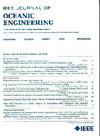Temporal Temperature Profile Prediction Using Graph Convolutional Networks and Inverted Echosounder Measurements
IF 3.8
2区 工程技术
Q1 ENGINEERING, CIVIL
引用次数: 0
Abstract
Ocean temperature prediction is a prominent research topic in current ocean science. The empirical modal method, which is based on the inverse echosounder, is one of the most significant methods for analyzing the physical environment of the deep-sea sound layer. This method effectively inverts the temperature profile of the research area. In this article, we propose the time- and self-attention mechanism graph convolutional neural network (ASeTGCN) that uses the inverted data. Unlike traditional time-series forecasting methods, ASeTGCN utilizes graph convolutional networks to capture the inherent spatial correlation of the research area. It also employs self-attention mechanisms to address the nonuniformity of temperature profiles at varying depths. Lastly, it uses time-attention mechanisms to analyze the correlation of temperature profile sequences sampled at daily, weekly, and monthly frequencies. We conducted multiple comparative experiments and related ablation experiments on the proposed model, and our results indicate that the model can effectively extend the time series of temperature profiles in the research area with a root-mean-square error of only 0.19.利用图卷积网络和反向回声测深测量预测时间温度分布
海洋温度预测是当前海洋科学的一个重要研究课题。基于逆回声测深仪的经验模态法是分析深海声层物理环境的重要方法之一。该方法有效地反演了研究区温度剖面。在本文中,我们提出了使用反向数据的时间和自注意机制图卷积神经网络(ASeTGCN)。与传统的时间序列预测方法不同,ASeTGCN利用图卷积网络捕捉研究区域的内在空间相关性。它还采用自关注机制来解决不同深度温度分布的不均匀性。最后,利用时间-注意力机制分析日、周、月采样温度剖面序列的相关性。我们对所提出的模型进行了多次对比实验和相关烧蚀实验,结果表明,该模型可以有效地扩展研究区域的温度分布时间序列,均方根误差仅为0.19。
本文章由计算机程序翻译,如有差异,请以英文原文为准。
求助全文
约1分钟内获得全文
求助全文
来源期刊

IEEE Journal of Oceanic Engineering
工程技术-工程:大洋
CiteScore
9.60
自引率
12.20%
发文量
86
审稿时长
12 months
期刊介绍:
The IEEE Journal of Oceanic Engineering (ISSN 0364-9059) is the online-only quarterly publication of the IEEE Oceanic Engineering Society (IEEE OES). The scope of the Journal is the field of interest of the IEEE OES, which encompasses all aspects of science, engineering, and technology that address research, development, and operations pertaining to all bodies of water. This includes the creation of new capabilities and technologies from concept design through prototypes, testing, and operational systems to sense, explore, understand, develop, use, and responsibly manage natural resources.
 求助内容:
求助内容: 应助结果提醒方式:
应助结果提醒方式:


